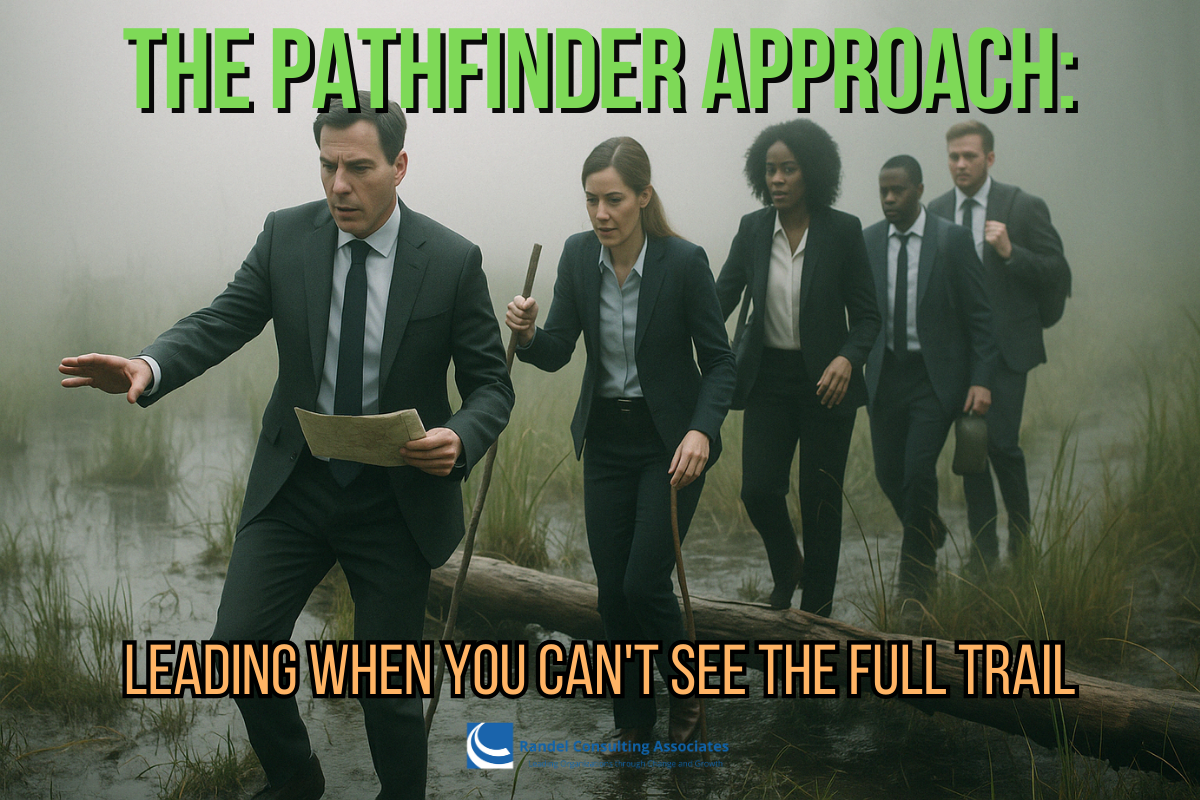Dear Change Leader,
“How are you doing?” I asked a leader recently.
“I’m taking it one day at a time, and I’m okay with that,” he replied, a note of celebration in his voice.
You see, until we connected in a CEO Roundtable I was hosting, he had been worried that his ability to focus on ‘just’ one day at a time meant that he was failing as a leader.
He had been feeling that, as a leader, he was expected to ‘have his act together,’ to bring reassurance to his staff, and to lead them confidently into the future. But he wasn’t feeling it… He didn’t feel confidence in the organization’s immediate future, given all the disruptions they were encountering, and he wasn’t at all sure that he had his own sh** together, given how dysregulated he was feeling.
The CEO Roundtable, and the trusting conversations taking place there among peer leaders, helped him realize that he was not alone. Other, more experienced leaders are also struggling at this moment. And the traditional tools used by leaders to face the future—such as multi-year strategic plans—no longer made sense when you couldn’t even be sure what would be facing you three months from now.
The Return of Radical Uncertainty
“It’s like we’re back in May 2020,” remarked another leader. “Everything has been disrupted, the familiar routines and practices don’t work any longer. We don’t know how long it will be before we return to normal. And we have no idea what new shocks and challenges next week will bring us…“
When things are uncertain, when there could be unknown risks around every corner, the last thing you should be doing is behaving as if nothing has changed. Carrying on as normal, following the same routines, and maintaining the same organizational timelines, can blind you to the reality that the ground has shifted under your feet.
You can no longer be certain that the path you are following is firm and able to support your weight. Perhaps it can, or perhaps the apparently well-trodden path has become quicksand, waiting to entrap you and break your stride.
At times like this, it’s time to adopt a “pathfinder” approach.
The Terrain of Leadership
If you’ve ever been on a nature walk, you’ll be familiar with the ways in which terrain can change dramatically, often without warning.
- A clear, wide, gravel path invites you to pick up your pace, walk more briskly, knowing that the surface will be firm, solid, supporting you with no effort (or even much thought!) on your part.
- A rocky hillside requires you to step more carefully, with attention on finding firm footing, stepping on rocks that will not move unexpectedly. It’s still solid terrain, but more care is required as you transfer your weight.
- A wetland is a far more tricky landscape. It can be hard to tell whether the ground ahead is firm or marshy. What looks solid might be merely a crust on the surface, with deep mud lying beneath it. A watery area might sit over a solid platform, providing sure footing as you move forward.
As a hiker, you know that you can’t always proceed in a straight line. So too with leadership in uncertain times.
Becoming the Organizational Pathfinder
As a leader, your work as a pathfinder is to determine how to reach your destination when the map no longer matches the territory. Your primary goal is to find a route that moves you forward, but you can only do so by scouting out the next few steps on the journey.
Your role is to:
- Test before committing – Like placing your weight gradually on uncertain ground, test new approaches with small experiments before full commitment
- Look for alternative routes – There are likely many ways of reaching your destination; the most direct path may not be viable
- Recognize when to redirect – Be willing to step to the side, avoid obstacles, or even retrace your steps when you discover that the path will not allow you to proceed
- Set a pace appropriate to the terrain – Move quickly through stable environments but slow down when conditions are uncertain
“I’ve stopped apologizing for changing direction,” shared a CEO at our last roundtable. “I’m happy that we’ve survived one more month. And I feel supported by this group as I prepare to do this all over again.“
Practical Pathfinding: This Week’s Actions
- Morning Territory Scan: Start each day with a quick assessment of what’s changed in your environment. Spend 15 minutes reviewing: What news or developments might impact our path today? Which assumptions should we question?
- Create Scout Teams: Identify 2-3 critical uncertainties facing your organization. For each, assemble a small, diverse team tasked with exploring that territory and reporting back regularly with observations, not just conclusions.
- Normalize Course Correction: At your next team meeting, share a recent decision you’ve changed based on new information. Model how to say, “Based on what we’re seeing, we need to adjust our approach,” without defensiveness or apology.
- Develop Terrain Awareness: With your leadership team, map your current projects and initiatives against the three types of terrain:
- Clear path (predictable, stable)
- Rocky ground (challenging but navigable with care)
- Wetlands (highly uncertain, requiring testing each step)
Finding Your Way Forward
One of the most liberating realizations from our CEO Roundtable discussions has been that “one day at a time” isn’t a leadership failure—it’s a sophisticated response to genuine uncertainty.
The pathfinder doesn’t need to see the entire route to the destination. They need to skillfully navigate the terrain immediately ahead, making sound judgments about where to place the next step, while keeping the ultimate direction in mind.
There’s wisdom in acknowledging that some days, the most strategic thing you can do is find solid footing for just the next few steps.
Until next time,
DEVELOP YOUR PATHFINDER LEADERSHIP SKILLS
Are you ready to strengthen your ability to navigate uncertain terrain with confidence?
I’m excited to announce an upcoming program specifically designed for change leaders facing today’s unprecedented challenges. The Pathfinder’s Journey: Leading Through Uncertainty will provide you with practical frameworks, peer support, and expert guidance to help you:
- Develop a keen sense for assessing changing organizational terrain
- Build adaptive decision-making skills for rapidly shifting environments
- Create teams that can respond with agility to unexpected challenges
- Maintain your leadership presence and well-being during prolonged uncertainty
Program details are being finalized, but spaces will be limited.
If you’re curious about this opportunity, please click the button below to join the interest list. There’s no obligation, and you’d like to be among the first to receive information when applications open.
Those on the interest list will also receive a complimentary copy of my article “Leading Like A Gardener” – a practical resource to support your leadership journey.
I look forward to sharing more details soon!
EFFECTIVE CHANGE RESULTS FROM INTENTIONAL LEADERSHIP
We’re a leadership and organization development consultancy. My team and I work with leaders like you to prepare for and lead successful change processes.
Here’s why our clients call us:
- Leadership Coaching: I support leaders as they navigate transitions into new roles or expanded responsibilities.
- Group Coaching and Learning Programs: Bringing groups of leaders together, I facilitate learning experiences and months-long programs that equip people to be effective change leaders.
- Effective Teams and Stronger Organizations: I work with leaders and their teams with tailored processes that increase their effectiveness, building layers of aligned teams that transform organizations.


